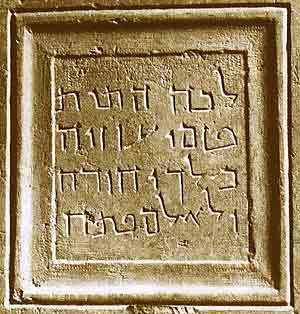Tomb Raiders - The Bones of Jesus
 Simcha Jacobovici is an archeologist/TV Director who has been compared to Indiana Jones by those who wish to discredit him. But yet that may be somewhat appropriate considering that his big real-life adventure is about to be released as a documentary film and the movie is produced by none-other than James Cameron, of Titanic fame.
Simcha Jacobovici is an archeologist/TV Director who has been compared to Indiana Jones by those who wish to discredit him. But yet that may be somewhat appropriate considering that his big real-life adventure is about to be released as a documentary film and the movie is produced by none-other than James Cameron, of Titanic fame.
This time though, it’s not about some legendary Shankara Stones, or the Holy Grail, or the Ark of the Covenant. This time, it’s about the actual skeletal remains of Jesus of Nazareth and his family.
The ancient city of Jerusalem is literally built on top of thousands of years of burial plots. In 1980, during a boom period of construction, in a part of Jerusalem called East Talpiot, there in the lot beside the home of Tova Bracha, they uncovered an ancient first century tomb. And in the tomb was the ossuary that contained the boxes where family members placed the bones of their deceased loved ones. It is very common to have ossuaries from that period in Jerusalem. But this one is special.
The names on the boxes actually say “Jesus, son of Joseph; Maria; Mariamene; Matthew; Judas, son of Jesus”; and “Jose” (a diminutive of Joseph) ” Also, there is a related box with the name “James, son of Joseph, brother of Jesus”.
Obviously, this is highly controversial. There are those who will refuse to believe that the bones of Jesus of Nazareth could ever be found on the Earthly realm, because, since his body was not found in the tomb the soldiers put him after his crucifixion death, they assume that he was bodily, physically taken up to heaven. That’s what they have believed for 2,000 years. They argue that Jesus is a very common name from that period, as is Maria (Mary), and James, and Matthew, and Joseph. They also argue that Jesus' family was probably too poor to have a family grave. Also, they believe that Jesus' mother Mary was buried in Ephesus, near Kusadasi, Turkey.
But there are the others who have done some research and they are equally convinced that this is, in fact, the “Holy Family” of Jesus of Nazareth. For one thing, to them the site seems a perfectly reasonable setting for a family of their stature to inter their deceased within. Also, it somehow seems much more believable to them that the family came and took his body back in the middle of the night from the tomb the soldiers put him in, rather than accept the notion that he rose bodily to Heaven.
Thirdly, there are the names. Yes, they were not uncommon names for the period – but that exact combination is. A father named Joseph, a mother named Mary (Maria), a son named Jesus, brothers named Joseph (or Jose) and James (The Gospel of Mark says these were two of Jesus’ four brothers), - this combination is statistically very unlikely. In fact, a statistician from University of Toronto named Andrey Feuerverger, calculates that the odds are 600 to 1 in favor of this being the original family of Jesus Christ.
Further evidence in favor of this theory is that in recent years, biblical scholars have determined that Mary Magdalene’s real name was “Mariamene”, and that she was Jesus’ wife, and DNA evidence scraped from the bones shows that the bones of Jesus and Mariamene are not related, and yet they were buried together in a family ossuary, implying that they were a married couple. We can probably assume that DNA testing will continue to see if the bones of Jesus' son, Judas, contain similar DNA sequences to both Jesus and Mariamene.
Of course, there will be continued controversy over this, as there always is with subjects that touch upon the ingrained religious beliefs of many people.
I was there in Jerusalem in 1989, and I found it very interesting that the local Jews living there don’t seem to treat the history of Christ with any special reverence. To them, of course, he was a historical figure, but not a God as he is to Christians. As I walked the narrow streets of the Old City of Jerusalem, the tour guide pointed out the exact actual places that are the “Stations of the Cross” denoted in every Catholic Church I had ever been to as a child growing up. I was amazed, when she pointed to the impression of a hand on the wall at one of the stations and said this was the handprint of Jesus when he leaned against the wall for support while carrying his cross. The cement mixture was soft and his hand left a permanent imprint there. I wondered why, if this was true, it was not more publicized within the Christian Church. While I stood there staring incredulously, A few feet away, there was a table with people selling Elvis soaps and Jesus soaps. To them they are both the same thing, a famous figure from the past, whose image can sell cheap merchandise to stupid tourists. Except that Jesus was the local boy. Elvis was someone from far away. Other than serving as a tourism draw for Christians from around the world, Jesus of Nazareth is simply not that important a person to the Jews of Israel.
Imagine if the townspeople of a small rural town in Texas discovered a historical site nearby that was of great religious significance - to Muslims. It would be of similar relevance.
In a completely consistent manner, Tova Brachs shrugs, laughs and wonders if the value of her home will go up since she has such a famous neighbor. She says, “Maybe I can make a fortune selling trinkets to tourists”.
The film documentary “The Jesus Family Tomb”, produced by James Cameron, will be seen on the Discovery Channel in the week of March 7th.


0 Comments:
Post a Comment
<< Home